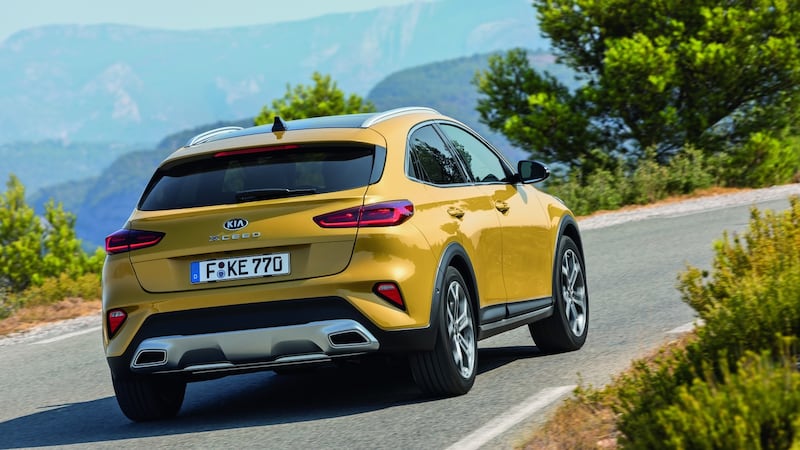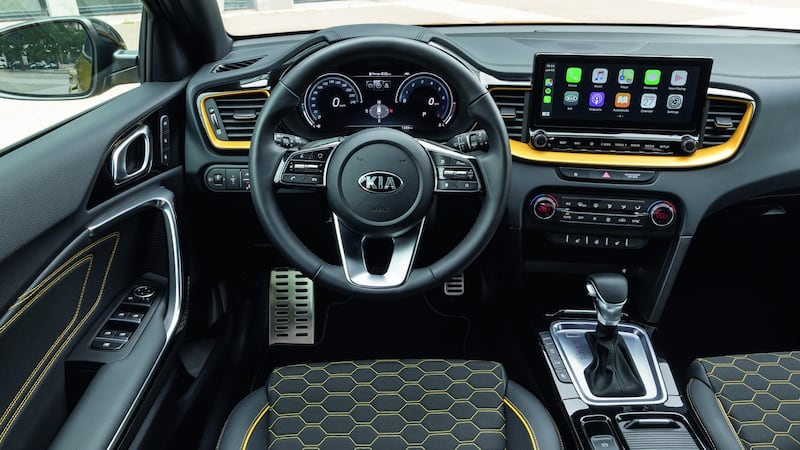The new Kia XCeed appears to have an identity crisis. On one hand it wants to be an SUV and on the other it wants to be a dynamic hatchback: it can't have it both ways.
The Ceed range is already comprehensive with a five-door hatchback, the SW estate and the Proceed shooting brake coupé family car. So why add another niche with XCeed?
Yet there is more method than madness in its decision. Kia says the XCeed’s styling is the result of a crossover car design trend that began three or four years ago. And, as my colleague Michael McAleer reckons, it’s the best looking Ceed in the bunch. It’s also right on the money in terms of catching the public appetite for crossover cars. And for these buyers design is all-important.
According to a survey referenced by Kia, crossover buyers rate exterior design above all other attributes at a whopping 64 per cent. To put this in context, durability, a quality high on any SUV buyer’s lists is in second place at 11 per cent.
The XCeed uses lots of the seen and unseen bits and pieces from the regular hatchback. Its front wheel drive only, has five doors and five seats. Interior space is good for four occupants and comparable to a Nissan Qashqai. There is a decent split-floor boot too at 426 litres that is 31 litres larger than the hatch, but Kia says according to its research none of these features are particularly important for potential purchasers. As the survey shows, design is key. And in this regard the Kia exceeds expectations (oh, go on, you knew it was coming...).

The XCeed has the same 2,650mm wheelbase as other Ceeds but its body is longer than the hatch. The front overhang gets an additional 25mm while the rear gains 60mm. The car next to an SUV has surprisingly compact proportions and is 90mm shorter than the Kia Sportage. The XCeed's ride height of 184mm is 37mm-44mm higher than the hatchback and is similar to a Mercedes-Benz GLA. This height above the road surface is achieved by using longer springs and new wheel and tyre combinations with a larger diameter.
The cabin is airy with good head, leg and shoulder room. Visibility is good too with a nice slightly elevated driving position. The seating comes with a choice of fabrics from cloth, cloth leather and faux and genuine seats. There is a new contrasting stitching seat option as part of a yellow colour pack. An impressive 10.25 inch centre touch screen with K2 and K3 models comes with Bluetooth multi-connection as standard. This allows occupants connect two mobile devices at once, as well as Apple CarPlay and Android Auto. The screen can be customised/split to display numerous vehicle features at the same time. For the first time in a Kia there is the option of a fully digital 12.3 inch driver’s display.

The XCeed’s pricing starts below the Proceed’s (€28,946) at €26,245 and is dearer than the hatchback at €22,695. An automatic gearbox option is available with the diesel while a six speed manual is standard. Just one petrol and one diesel 1.6 litre four cylinder engine are offered, and both are turbocharged. A 1.4 petrol may come to our shores if demand is strong enough. For now the three cylinder 1 litre petrol produces 120hp/172nm and makes sense for low mileage urban use.
Those looking for low emissions and ease of use should consider the plug-in hybrid (PHEV) version that’s on the way. Due in January 2020 the XCeed PHEV combines a 8.9kWh lithium-polymer battery pack, a 44.5 kW electric motor, and a tuned 1.6-litre ‘Kappa’ four-cylinder GDI petrol engine. The automatic transmission is a six-speed double-clutch transmission. Power is quoted at 141hp/265nm. The PHEV will deliver up to 60km of electric only driving range depending on wheel size. A CO2 figure and exact pricing have not been confirmed but expect a price higher than the Kia Niro’s €31,500.
We tested a diesel and 1.4 petrol on a mix of roads in and around Marseille. The car coped well with the poor surfaces and at times brutal traffic calming. The XCeed's ride is more comfortable than the hatch due thanks to the extra suspension travel.
By fitting hydraulic bump stoppers in the front shock absorbers Kia has reduced the car’s harshness over bumps. The XCeed’s stability control system, shock absorbers, springs and steering have all been tuned and tweaked to enhance the ride, plus larger brakes have been fitted.
On the open road the XCeed handles reasonably well. Its higher centre of gravity is barely noticeable when cornering in normal driving. On more dynamic routes you feel more connected than in a taller Sportage for example and rides quite flat through bends. It is mildly engaging behind the wheel but is not quite the dynamic hatch Kia claims.
Kia Ireland expects XCeed sales of 1,100 in 2020 with the PHEV contributing circa 500, petrol similar 500 and diesel around 100. Kia is a growing brand and one of only four car brands to gain positive share in Europe during the first six months of this year.
The XCeed may be regarded as a niche addition to the Ceed hatchback range, but given the appetite for crossovers - and the fact this car looks so good - it could well become the mainstream choice in the Ceed range.
Lowdown: Kia XCeed CRDi (diesel) K3
Power: 115hp
Torque: 280nm
0-100km/h: 11.4 seconds
Top Speed: 190km/h
Claimed fuel economy: 4.1l/100km (68.8mpg)
CO2 emissions: 109-114g/km (NEDC)
Motor tax: €190-€200
Price: €31,000 (indicative price)
Verdict: A nice hatchback with notions
Our rating: Three stars










